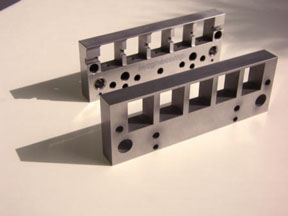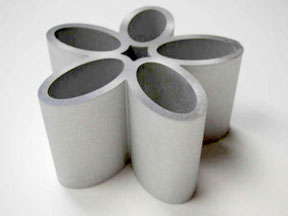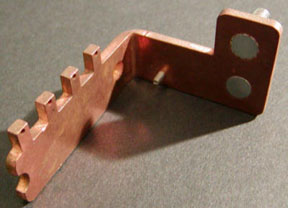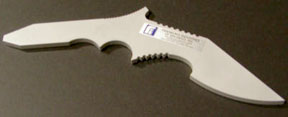|
Non Ferrous Metals . . . What Are Non Ferrous Metals?
Non Ferrous Metals . . . What are they? What are the properties of stainless steel? Is aluminum corrosion an advantage? What alloy metals are ferrous?
Non Ferrous? Wet Jet Precision, Inc. is your source for great information. Go ahead, ask. Yes I'd like to know what does non ferrous mean? A ferrous material means it contains iron. Soooo . . . non ferrous means . . . right! No iron! However, non ferrous metals typically are not defined as having absolutely no iron, just minimal iron content. Ferrous metals include steel and pig iron, which is reprocessed into wrought iron.
What is an alloy? It is a mixture of two or more elements in solid solution. It makes sense then that in this context, the major component must be a metalic element. All metals are typically referenced as alloys, even mild steel is alloyed with a small amount of carbon. Many times mild steel will be referred to as A36. This is an ASTM International standard designation. Other carbon steels will typically reference a higher number to indicate higher carbon content. As the carbon content rises, the metal becomes harder and stronger, but less malleable and harder to weld. About 85% of all steel used in the United States is designated as carbon steel.

Well. . . now I know what ferrous metals are . . . tell me about non ferrous metals. Wow, that's a big order even if it is only the other 15%, it is a big, big subject. Consider all of the other alloy possibilities. I will take a deep breath . . .

Alloys of . . . 
These are just the alloy groups. Metallurgists mix and match these elements to produce alloys with unique structures and properties. I will only discuss some of the more commonly used alloys. Mild steel, is generally not referred to as an alloy although it is. Aluminum is the most widely used non ferrous metal. In its elemental state, it is the 3rd most abundant element. Click on the following link if you are still wondering about the advantages of aluminum corrosion. Aluminum alloys are very important to industry, particularly for the transportation industry. Of course, Stainless Steel is right there close behind. The Properties of Stainless Steel are important to understand. They are probably the non ferrous metals most in demand. Then we have the more common alloys of copper, which are brass and bronze, and the common nickel alloys, which are chrome, inconel, and hastelloy. When speaking of copper or titanium, typically those terms are used loosely as though anything that resembles copper or titanium is fair game. In reality, this reference is not of the pure element, but rather an alloy of copper or titanium. Very seldom will a metal be procured for a project in its elemental state. We can't forget the precious metals. Common precious metal alloys for silver are sterling silver and platinum, and for gold, it is most commonly alloyed with silver, copper and nickel. Gold is expressed in karats, which tell you the ratio of the alloy. Gold that is 24 karat is understood in most places around the world to be 99.9% pure. So a 14 karat gold piece would indicate a ratio of 14/24. All alloys have properties that have various strengths and weaknesses. When specifying a material for a project such as Knife Steel for a handmade knife, it can be very critical to understand these strengths and weaknesses. Click for additional information from the Steel Suppliers Guide! For ongoing tips and information on Water Jet Cutting and related processes, Subscribe to our Newsletter, "A Cut Above the Rest!" Click Here! to Subscribe, top left. Wet Jet Precision's Abrasive Water Jet Cutting machine is available to help with your project or part!
To discuss your quote specifications for . . . Abrasive Waterjet Cutting, Contact Us! return from Non Ferrous Metals . . . to Water Jet Cutting Home
|







